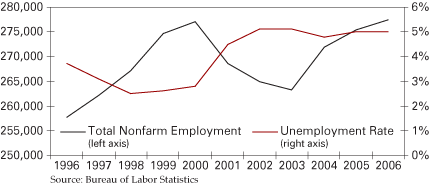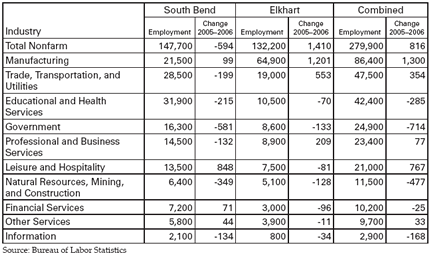South Bend and Elkhart-Goshen
School of Business and Economics, Indiana University, South Bend
The Michiana region, composed of the metropolitan areas of South Bend–Mishawaka and Elkhart–Goshen, faced a modest economy in 2006. The year started with promise that weakened in late spring and summer. However, hope has rekindled as conditions improve late in the year. Given ongoing uncertainties about the local economy, as well as predictions for slower growth at the state and national levels, the outlook for 2007 is less promising than recent years.
Employment
Figure 1 shows the overall slowdown in the region’s employment growth. Unemployment rates throughout the region were generally lower in 2006 compared to 2005. Unemployment rates rose in the summer but turned downward again in August. Unlike in 2005, unemployment rates in South Bend exceeded the national and state averages throughout the year, while the unemployment rate in Elkhart remained below the national and state averages for the first half of 2006. While employment expanded, rising wages in the region may have attracted new entrants into the labor market that did not have sufficient demand to match.
Figure 1
Total Nonfarm Employment and Unemployment Rate in St. Joseph and Elkhart Counties Combined, 1996 to 2006

Table 1 reports employment data by industry for the region’s metropolitan areas. From September 2005 to September 2006, total nonfarm employment increased modestly by 0.3 percent: Elkhart experienced a relatively larger gain, adding more than 1,400 jobs while South Bend lost 594 jobs. Approximately 279,900 people are employed in nonfarm sectors across South Bend and Elkhart, with employment being about 15,500 higher in South Bend.
Table 1
Employment by Industry, September 2006
Manufacturing employment grew by 1,300 jobs due in part to a strong first quarter in 2006 for the RV industry that disproportionately benefited Elkhart. Manufacturing employment may be more uncertain in the year ahead, as local labor relations remain unstable, plant closings take affect, and side effects from the domestic auto industry’s downturn on local producers and suppliers are yet to be fully felt. As an indicator, RV shipments in August 2006 were 2.4 percent lower than in August 2005, though cumulative 2006 shipments exceeded 2005 shipments by approximately 29,000 units. Additionally, two local vehicle suppliers, Adapto and Gunite, announced plant closings that could see 276 workers to 376 workers laid off, and AM General has initiated temporary shutdowns in response to weakening demand for the commercial Hummer H2. Moreover, the Bach labor strike continues, lasting eight months to date.
Nonmanufacturing employment saw mixed results. Sectors gaining the most were trade, transportation, and utilities in Elkhart; leisure and hospitality in South Bend; and professional and business services in Elkhart. Sizeable job losses occurred in government, construction, education, and information services across the region. Professional and business services lost jobs in South Bend, while financial services suffered losses in Elkhart. Continued growth in health care, retail, and other services and a resurgence of construction due to new projects, such as Major Moves, should contribute to nonmanufacturing employment growth in 2007.
Wages
The average weekly wage rose 6.3 percent from the first quarter of 2005 to the first quarter of 2006 in South Bend but jumped 10.5 percent in Elkhart. This represented much faster growth than seen the previous year, which saw a 0.3 percent rise in South Bend and a 1.6 percent rise in Elkhart. Wage growth varied by industry. Manufacturing wages grew 6 percent in South Bend but 14.7 percent in Elkhart. Wages in retail also rose, 6 percent in South Bend and 4.8 percent in Elkhart. Wages in the health care and social services industry grew at a much slower pace, 3.6 percent in South Bend and 1.7 percent in Elkhart. The sizeable wage increases in 2006 were driven largely by inflationary adjustments and increases in productivity. If inflationary pressures diminish as expected, wage growth will likely slow in 2007, particularly if economic conditions slow productivity.
Housing
Residential construction, measured by the number of new single-dwelling housing permits issued in St. Joseph County, changed dramatically in 2006 compared to 2005. From January 2006 to September 2006, 313 new housing permits were issued, compared to 482 during the same period in 2005. While local housing prices have not fluctuated to the extent in other areas around the country, this slowing of new housing suggests the Michiana market is not immune to the national housing slowdown driven by weakening demand, falling housing prices, and growing inventories of existing homes (see Figure 2).
Figure 2
Single-Family Residential Building Permits, 2004 to 2006

Summary
In 2006, the Michiana region experienced mixed economic signals: fairly flat employment, relatively low but fluctuating unemployment rates, rising wages, and slower real estate markets. The outlook for the coming year is encouraging but cautious, with the region seeing expanded production in some manufacturing and nonmanufacturing sectors, higher employment, and slowing growth in wages, along with uncertainties about future economic conditions.
Also in this Issue…
- Outlook for 2007
- The International Economy
- The U.S. Economy
- Financial Forecast
- Housing
- Indiana Agriculture
- Indiana
- Anderson and Muncie
- Bloomington
- Columbus
- Evansville
- Fort Wayne
- Gary
- Indianapolis
- Kokomo
- New Albany
- Richmond
- South Bend and Elkhart-Goshen
- Terre Haute
- Indiana Metro Economies at a Glance
- Return to Table of Contents




